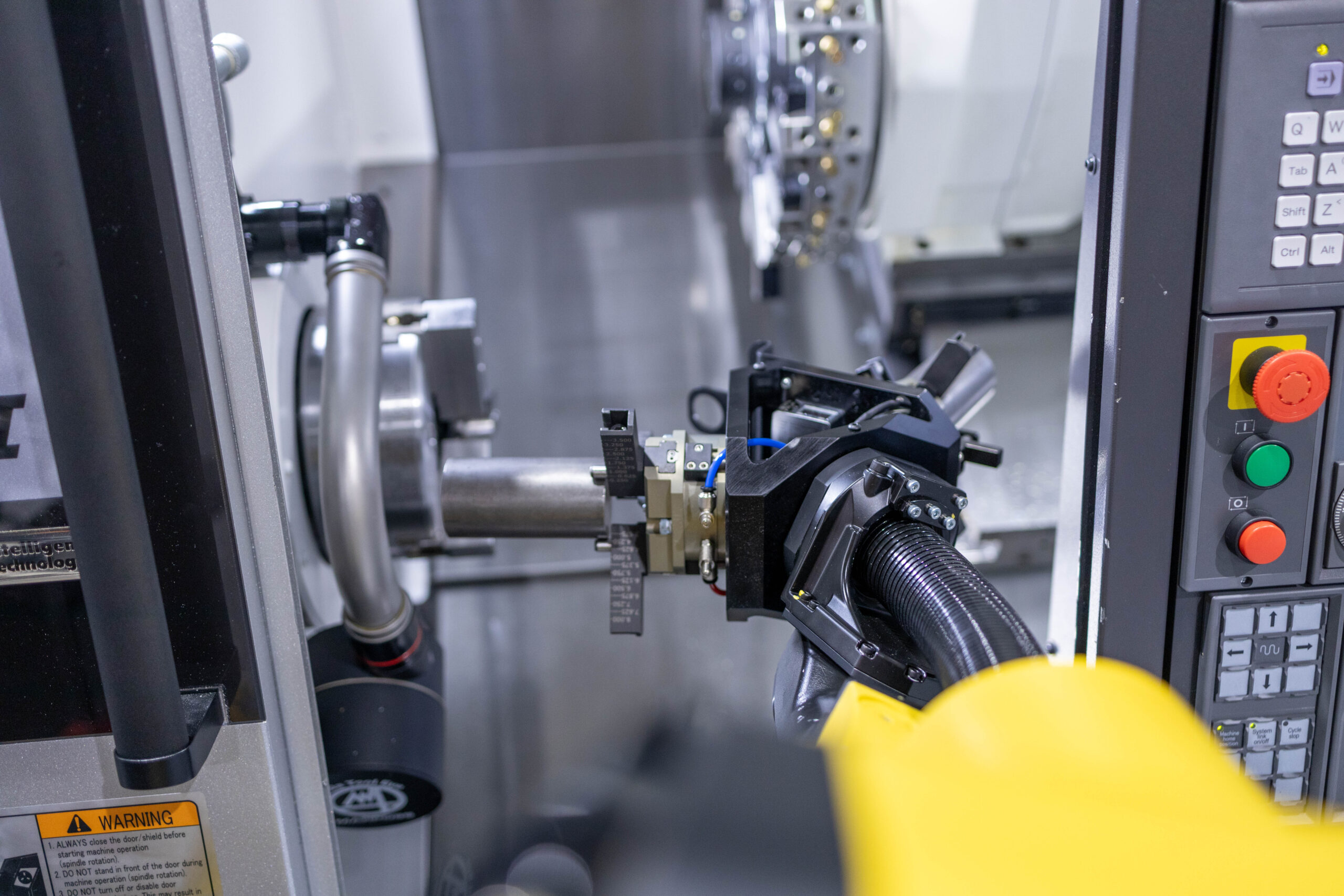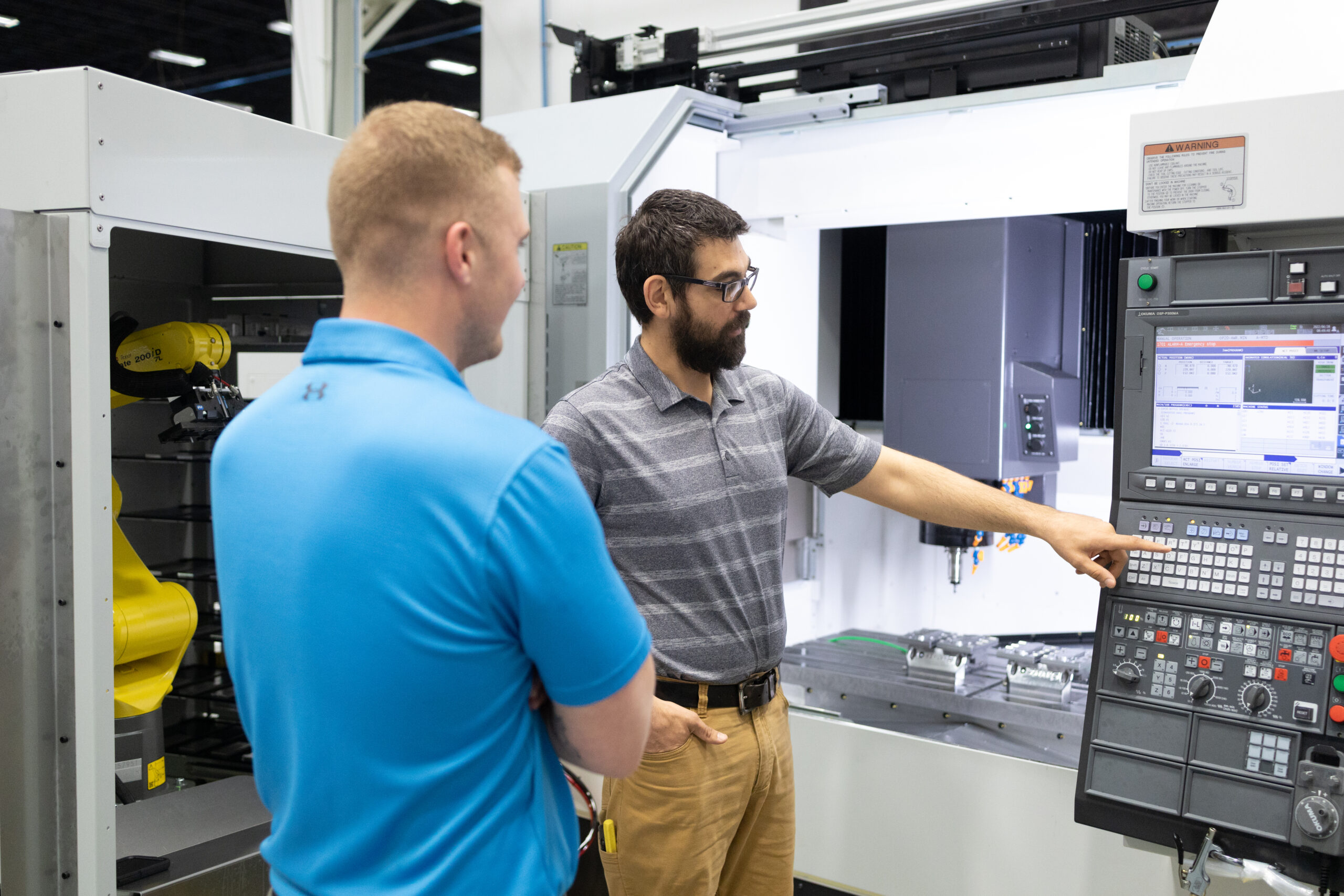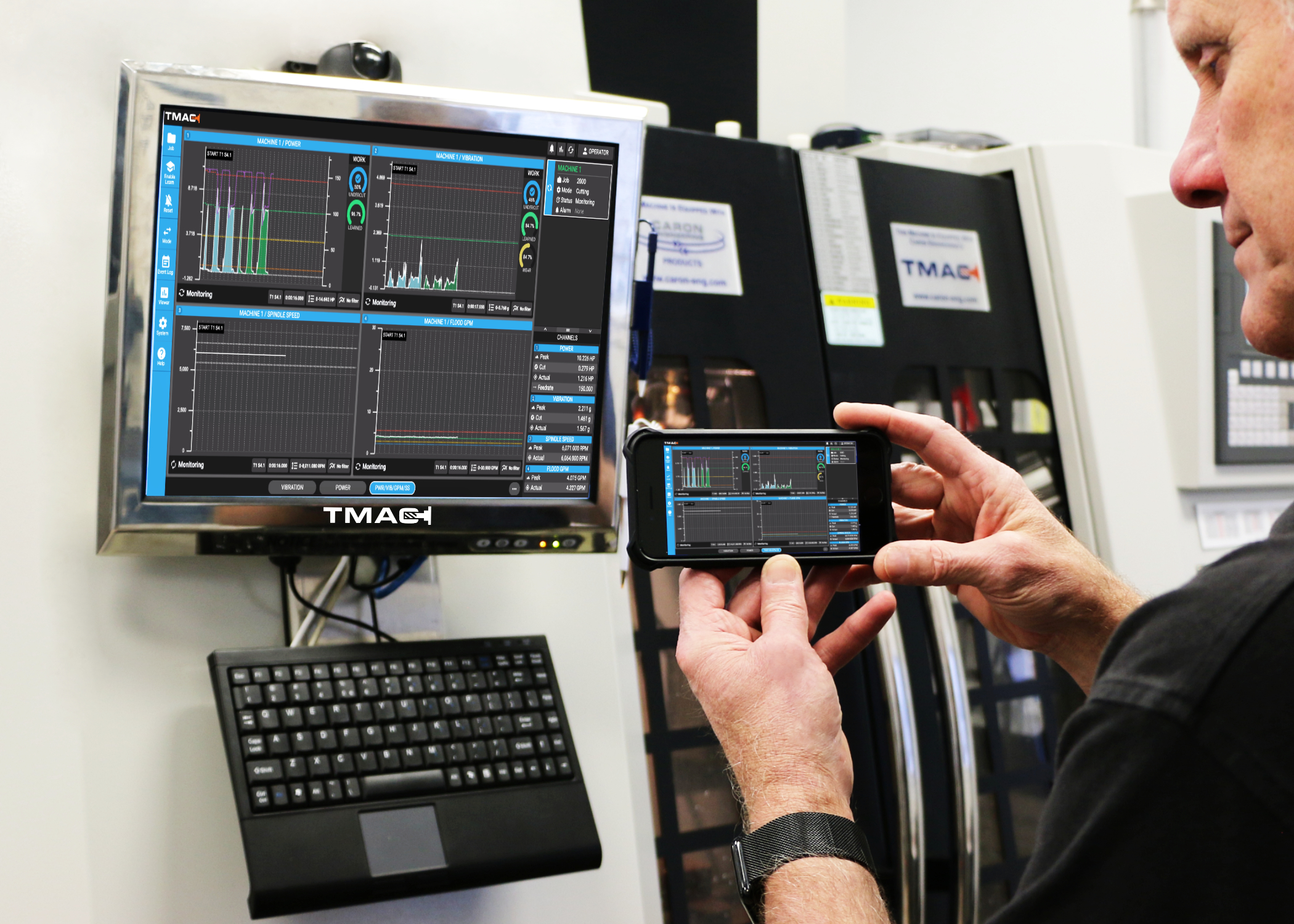As we look ahead to 2024, CNC industry trends signal a major shift towards advanced technology and sustainability. This article delves into the pivotal trends shaping this sector, focusing on the integration of Artificial Intelligence, the rise of smart factories and the industrial metaverse, the evolution of digital supply chain solutions, and the transformation of aftermarket services through AR and VR. These advancements are not just redefining manufacturing processes but are also setting new standards for efficiency, productivity, and adaptability in a rapidly changing industrial landscape.
With this backdrop of technological revolution, let’s first explore how increased automation and robotics are becoming key solutions to the industry’s labor challenges.
2024 CNC Machining Innovations: Automation and Robotics

A major trend in the CNC industry for 2024 is the growing use of automation and robotics. This marks a pivotal shift in CNC machining operations, reflecting a response to evolving sector needs and challenges.
The rise in automation and robotics in CNC machining is driven by technological advancements and economic needs. Improved technology has made these tools more intuitive and accessible, similar to smartphones. This enables companies to adopt advanced robotics more easily, without needing extensive training.
Moreover, automation and robotics are filling a critical gap in the industry: the shortage of skilled labor. Across the U.S., the manufacturing sector is grappling with a talent crunch. Automation offers a viable solution by performing tasks that would have otherwise required skilled human labor. This isn’t just about replacing manpower; it’s about enhancing capabilities and bridging the skill gap with technology. The use of robotics, for instance, has allowed companies to undertake complex machining tasks that would have been challenging or inefficient to perform manually.
As automation reshapes our approach to production, it simultaneously addresses some of the most pressing labor issues facing the industry today.
Future of CNC Machining 2024: Tackling Labor Challenges

As we move through 2024, it’s becoming increasingly clear that addressing labor issues is not just a necessity but a strategic imperative for companies wanting to thrive. Addressing labor issues effectively is vital for adapting to the future of CNC machining in 2024, a year that is shaping up to be transformative.
Many manufacturing workers in the U.S. are nearing retirement, with about a quarter of the workforce over 55. This imminent labor shortage, predicted by the Society for Human Resource Management in 2015, poses significant challenges to the industry’s competitiveness and the U.S. economy.
Manufacturing’s image has evolved from a ‘dirty’ job to a high-tech, dynamic career, demanding skilled workers. Proactively, schools are introducing students to manufacturing roles, promoting a diverse, multi-generational workforce.
One effective strategy to bridge this gap is the development of mentorship programs. These programs provide a platform for older, experienced workers to pass on their knowledge to younger apprentices. Such initiatives not only help in retaining and transferring crucial skills but also foster a culture of collaboration and learning across generations. It’s a bidirectional learning process, where seasoned employees share their expertise while also gaining insights into new technologies from younger colleagues.
Looking ahead, the industry’s evolution is clear. Many of today’s manual tasks are becoming automated, and roles are shifting towards more technically demanding positions. This transition presents an opportunity for workers to take on more challenging, value-added roles that automation cannot fulfill. It’s essential to recognize that the future of manufacturing lies in its ability to adapt, leveraging the Industrial Internet of Things (IIoT), augmented reality (AR), virtual reality (VR), and other technologies. This evolution requires a workforce that is versatile, tech-savvy, and prepared for the demands of Industry 4.0-driven factories.
Understanding these labor dynamics is crucial as we delve into the broader economic factors and strategic positioning shaping CNC machining in 2024.
CNC Technology Advances 2024: Economic and Market Insights
As we navigate through 2024, understanding the economic factors influencing CNC technology advances is crucial for staying ahead in the industry. These elements are crucial in understanding how the industry is evolving and where opportunities for growth and innovation lie.
- Legislative Impact and Investment Growth: The U.S. manufacturing sector, including CNC machining, has been invigorated by legislation such as the Infrastructure Investment and Jobs Act (IIJA), the CHIPS and Science Act, and the Inflation Reduction Act (IRA). These laws focus on rebuilding infrastructure, advancing clean energy, and developing the domestic semiconductor industry, thereby spurring substantial private sector investment across various sectors. The result is a significant increase in construction spending and a promising outlook for industry growth in 2024.
- Challenges and Technological Integration: Despite the positive momentum, the industry faces challenges like economic uncertainty, skilled labor shortages, and supply chain disruptions. To tackle these, manufacturers are increasingly turning to technology. There’s a growing adoption of smart factory solutions and the exploration of the industrial metaverse. This technological integration, including AI and IoT technologies, is driving innovation, reducing operational costs, and enhancing efficiency.
- Market Growth Projections and Industry Value: The CNC machining market is anticipated to grow substantially, with the global CNC machine market expected to reach nearly $129 billion by 2026. This growth is fueled by the need to reduce operating costs, use manpower more efficiently, and adopt IoT technologies and predictive analytics. CNC machining is becoming increasingly important in sectors like automotive, defense, medical, and aviation, with precision engineering emerging as the fastest-growing segment.
- Reducing Operating Costs and Ensuring Quality: The integration of computer-aided manufacturing (CAM) and design (CAD) in product design and prototyping has enhanced the ability to deliver high-precision components on time. This adoption of CNC equipment not only reduces operating costs but also improves mass production efficiency. As a result, manufacturers continue to invest in smart tools and automation technology to streamline processes and improve productivity.
- Reshoring as a Strategic Response: The manufacturing industry is increasingly considering reshoring – bringing manufacturing back to the United States from overseas. This trend has emerged in response to challenges like increased shipping costs and supply chain disruptions. Reshoring can stimulate the economy by generating jobs, fostering innovation, and improving speed to market. Companies are adopting this strategy to become more resilient and less susceptible to global crises.
In summary, the CNC machining industry in 2024 is poised for growth, driven by legislative support, technological advancements, and strategic reshoring efforts. These factors are reshaping the industry, making it more efficient, sustainable, and resilient in the face of global economic challenges. Manufacturers that adapt to these changes and leverage the opportunities presented will likely see success in this dynamic environment.
These economic and strategic shifts pave the way for another significant trend: the industry’s growing focus on sustainability and energy efficiency.
Push for Sustainability and Energy Efficiency in CNC Machining
Sustainability and energy efficiency are emerging as prominent CNC industry trends in 2024, reflecting a shift towards more environmentally conscious manufacturing practices. This change is driven by a combination of technological advancements, evolving market demands, and a growing commitment to environmental stewardship.
- Sustainable Practices and Green Manufacturing: The shift towards more sustainable manufacturing solutions in CNC machining is becoming increasingly pronounced. One key aspect of this transition is the reduction of the carbon footprint. CNC machining contributes to sustainability by allowing for electronic file transmission, thus reducing the need for physical transportation and associated emissions. Additionally, the integration of AI and IoT within smart factories has revolutionized CNC machining, resulting in more efficient and less wasteful production processes.
- Advancements in Eco-Friendly Materials: The industry’s move towards using sustainable materials marks a significant step in its evolution. This includes biodegradable plastics, recycled metal alloys, and advanced composites made from natural fibers. These materials help reduce environmental impact without compromising product quality and performance. Alongside these material innovations, there is an increased focus on energy-efficient machinery and waste reduction strategies, further contributing to the industry’s ecological balance.
- The Rise of On-Demand Manufacturing and JIT Production: The concept of on-demand manufacturing, supported by advanced CNC technology, is reshaping the industry. This approach, which includes JIT manufacturing, aims to reduce waste and improve energy efficiency by producing only what is needed, when it is needed. The customization offered by CNC machining aligns with modern market dynamics, where consumers demand personalized products with rapid delivery times.
- Digital Twin Technology For Sustainability: Digital twin technology has become a critical component in sustainable CNC practices. By creating virtual models of physical CNC systems for simulation and control, manufacturers can improve efficiency, reduce material waste, and enhance precision. This innovative approach allows for detailed analysis and optimization of CNC operations, thereby reducing the environmental impact of manufacturing processes.
In summary, the push for sustainability and energy efficiency in CNC machining is a multifaceted movement encompassing the adoption of eco-friendly materials, advanced technologies, and innovative manufacturing practices. As the industry continues to evolve, these sustainable approaches are not only benefiting the environment but also enhancing operational efficiency and productivity, positioning CNC machining as a forward-thinking and responsible sector in the manufacturing industry.
As sustainable practices gain momentum, they also influence global resourcing trends, reflecting a shift in the industry’s approach to production and supply chains.
Global Resourcing in CNC Machining
The global resourcing strategies in the CNC industry in 2024 are evolving, highlighting a significant trend towards localized supply chains and reshoring. This change is characterized by emerging opportunities in the U.S. market, a response to the evolving global landscape, and the stabilization of markets.
- Increased Domestic Manufacturing and Reshoring: A notable trend in the global resourcing of CNC machined parts is the increasing inclination towards domestic manufacturing, often referred to as ‘reshoring’. This movement has been primarily fueled by the need for greater control over supply chains, which became a critical concern during the disruptions caused by recent global events. Reshoring helps mitigate risks associated with overseas production, such as delays, increased shipping costs, and communication challenges.
- Stabilization of U.S. Markets and Production Agility: The U.S. market is witnessing a stabilization that is drawing more CNC machining work back to domestic shores. This stability is allowing U.S. manufacturers to offer more competitive lead times and pricing, thanks to advancements in manufacturing technologies and more efficient logistics. Additionally, the ability to quickly respond to market demands and changes is a significant advantage of domestic production, providing agility that is often challenging to achieve with long-distance supply chains.
- Reshoring and its Growing Significance: Reshoring has become a key strategy in global manufacturing, particularly in the CNC machining industry. The trend of bringing manufacturing back to the U.S. from overseas has accelerated due to supply chain disruptions caused by global events like the pandemic and geopolitical tensions. Reshoring helps mitigate risks associated with overseas production and offers benefits such as reduced costs, enhanced control over manufacturing processes, faster market response times, and local job creation. In 2022, the U.S. saw a record increase in reshoring and foreign direct investment jobs, indicating a substantial shift towards domestic production.
- Growth of the Global CNC Machine Market: The global CNC machine market is expected to reach approximately $128.86 billion by 2026, with a steady growth rate. This growth is fueled by factors like the need to reduce operating costs, improve manpower efficiency, and adopt advanced technologies such as IoT and predictive analytics. The rise of Industry 4.0 and automation across production processes also contributes significantly to this growth. Key industrial sectors like automotive, defense, medical, and aviation rely on CNC machining, making precision engineering a rapidly growing segment.
The global resourcing trends in CNC machining in 2024 are marked by a significant shift towards domestic manufacturing in the U.S., driven by the reshoring movement and the need for greater supply chain control. At the same time, the global CNC machine market is witnessing robust growth, propelled by technological advancements and the increasing influence of key players in the Asian CNC industry. Amidst these global changes, let’s turn our attention to the technological innovations within CNC machining, starting with the role of Artificial Intelligence.”
Adoption of Artificial Intelligence in CNC Machining

The adoption of Artificial Intelligence in CNC machining is a standout trend for 2024, revolutionizing various facets of the industry. This transformation is characterized by three key developments:
- AI-Assisted Design and Manufacturing Optimization: AI technologies, exemplified by Siemens Solid Edge 2024, are revolutionizing assembly design by predicting assembly relationships, thereby streamlining design processes, and minimizing manual adjustments. This innovation accelerates product development and fosters efficient operation management, showcasing a significant advancement in AI’s role in CNC machining.
- Enhanced Data Analysis and Predictive Maintenance: AI’s ability to analyze vast amounts of data quickly and in real-time is transforming manufacturing. By integrating Industrial Internet of Things (IoT) devices and sensors, AI algorithms process and analyze data from machines and production lines. This capability enables manufacturers to gain a deeper understanding of their production processes, identify irregularities, and conduct predictive maintenance, optimizing supply chain management and enhancing workplace safety.
- Economic and Productivity Gains: The incorporation of AI into CNC machines leads to improved efficiency and cost-effectiveness. Real-time data analysis facilitates immediate performance adjustments and predictive maintenance, contributing to significant economic benefits.
- Industry Transformation and Future Outlook: AI in CNC machining is setting the stage for a comprehensive industry transformation. Predictive maintenance, facilitated by AI, enables optimal timing for machine servicing and tune-ups, crucial for maintaining peak shop floor performance. As AI technology evolves, it’s anticipated that its integration will deepen, paving the way for more sophisticated, efficient, and automated CNC machining processes.
The adoption of AI in CNC machining is redefining the industry’s landscape in 2024. Its impact is evident in enhanced design processes, improved operational efficiency, and significant economic benefits. AI’s integration is just the beginning; the emergence of smart factories and the industrial metaverse further illustrates the industry’s technological evolution.
Smart Factory and Industrial Metaverse in CNC Machining
The integration of smart factory solutions and the exploration of the industrial metaverse are set to be pivotal CNC industry trends in 2024. This evolution is driven by a combination of technologies like AI, IoT, data analytics, and cloud computing.
- Smart Factory Transformations: Smart factory technologies, identified as pivotal for competitiveness in the manufacturing sector, are at the center of industry transformations. These technologies include AI, 5G, IoT, data analytics, and cloud computing, which are vital for offering real-time insights and end-to-end visibility in manufacturing processes. According to Deloitte’s 2024 Manufacturing Outlook, these smart factory solutions are key to overcoming challenges such as economic uncertainty, labor shortages, and supply chain disruptions.
- The Industrial Metaverse and Its Impact: The industrial metaverse represents a convergence of various technologies, creating immersive three-dimensional virtual environments. This technological advancement is anticipated to transform research and development, design, and innovation in manufacturing. It offers new ways to solve challenges like attracting and retaining top talent and building supply chain visibility and resilience. Frontline workers in manufacturing can benefit significantly from augmented and mixed reality (AR and MR) technologies, part of the industrial metaverse. These technologies enable workers to access information, step-by-step workflows, and interactive 3D holograms, thereby improving efficiency and accuracy in their tasks.
- Adoption and Challenges: While the adoption of the industrial metaverse is gaining momentum, challenges such as implementation costs, lack of skilled talent, and interoperability concerns persist. Despite these barriers, surveyed executives believe the value delivered by the metaverse outweighs the cybersecurity risks, especially with the right mitigation strategies in place. Deloitte’s survey also reveals that approximately 86% of manufacturing executives view smart factory solutions as key drivers of competitiveness in the next five years, with the industrial metaverse expected to contribute a 12% gain in labor productivity.
As we advance into 2024, the integration of smart factory solutions and the industrial metaverse in manufacturing, including CNC machining, is set to offer transformative benefits. These technologies are reshaping the industry, enhancing operational agility, resilience, and efficiency. The proactive adoption of these solutions, despite the challenges, signals a significant shift towards more innovative and responsive manufacturing practices.
The smart factory concept naturally extends into another key area: the digitization of supply chains, crucial for meeting today’s manufacturing demands.”
Digital Supply Chain Solutions
In 2024, manufacturers are increasingly adopting digital supply chain solutions to enhance visibility and resilience in response to supply chain disruptions. These solutions include the utilization of digital twins, blockchain technology, and smart contracts.
- Digital Twins: Digital twins have become a crucial component in the manufacturing industry, offering virtual replicas of physical systems or processes. They enable manufacturers to simulate, predict, and optimize their operations without disrupting actual production. This technology contributes to cost reductions, improved product quality, and accelerated time-to-market. It is forecasted that by 2024, 75% of industrial companies will utilize digital twins in some capacity.
- AI-Enabled Planning: AI is playing a significant role in transforming supply chain planning. It allows for low touch planning, significantly reducing manual work and utilizing advanced analytics to make more informed decisions with minimal human intervention. AI can analyze data at scale, identify anomalies, and suggest solutions to disruptions almost instantaneously.
- Blockchain and Smart Contracts: Blockchain and smart contracts are revolutionizing supply chain transactions, automating operations and maintenance for greater transparency and financial efficiency. They’re also expanding into areas like ESG reporting, further transforming operational components..
Overall, these digital supply chain solutions are revolutionizing the manufacturing industry by enhancing transparency, reliability, and responsiveness. They contribute to more efficient and resilient supply chains, which is essential in the face of ongoing disruptions and the evolving demands of the global market. Finally, these technological advancements culminate in significantly enhanced aftermarket services, where digital technologies like AR and VR are setting new standards in customer support and experience.
Enhanced Aftermarket Services
In 2024, the use of digital technologies such as Augmented Reality (AR) and Virtual Reality (VR) is significantly enhancing aftermarket services in the manufacturing industry. These technologies contribute to improving business continuity and customer satisfaction in several ways:
- Visualization and Process Optimization: AR and VR create simulations that aid engineers and operators in visualizing the entire manufacturing process. This helps in identifying potential bottlenecks and areas for improvement, thereby optimizing manufacturing processes. Additionally, AR/VR can be used in quality control by overlaying specifications or guidelines onto the production line for real-time quality checks.
- Training and Skill Development: VR, in particular, offers immense potential to enrich and supplement the workforce’s effectiveness and accuracy in decision-making and productivity. It enables the creation of a virtual alternate world where users can interact with elements and gain experiences. This is especially useful in training personnel through simulations, which can drastically reduce loss of time and material, and upgrade skill levels without putting expensive equipment or materials at risk.
- Enhanced Collaborative Working: By 2024, AR and VR technologies are being increasingly adopted for collaborative working, providing teams the ability to interact as though they were co-located across geographical barriers. This includes remote collaboration, enhancing teamwork, increasing productivity, and efficiency gains. Teams can interact with 3D models and data in real-time, irrespective of their physical location.
In conclusion, 2024 marks a year of significant transformation for the CNC machining industry, driven by technological innovations and market shifts. The integration of AI, adoption of smart factory and industrial metaverse concepts, advancements in digital supply chain solutions, and the enhancement of aftermarket services with AR and VR technologies collectively signal a new era of manufacturing excellence. These trends underscore the industry’s move towards more efficient, resilient, and customer-centric operations, highlighting the critical role of digital transformation in the future of manufacturing.
Sources
-
- Expert Market Research – “Europe CNC Machine Market”: Read More.
- Thomasnet – “CNC Machining Projected to be $100B Industry by 2025”: Read More.
- CNC Masters – “Manufacturing Trends”: Read More.
- KnowCNC – “Sustainable Practices in CNC Machining: How the Industry is Evolving in 2024”: Read More.
- Blue and Green Tomorrow – “What Green Businesses Can Expect from CNC Machining in the Future”: Read More.
- American Micro, Inc. – “Future CNC Machining Trends and Predictions”: Read More.
- Deloitte – “Manufacturing Industry Outlook”: Read More.
- MSC Direct – “Skills Gap: Why You Need to Develop a Multigenerational Workforce”: Read More.
- Supply Chain Brain – “The Promise of Digital Twins and Smart Contracts”: Read More.
- KPMG – “Supply Chain Trends 2024”: Read More.
- Aeologic – “Innovative Solutions for the Manufacturing Industry in 2024”: Read More.
- Manufacturing Tomorrow – “Why CNC Machining and AI Make a Perfect Match”: Read More.
- GoToMorris – “AI in CNC Manufacturing: Exploring the Future of Industry 4.0”: Read More.
- China Manufacturing – “AI for CNC Machining”: Read More.

